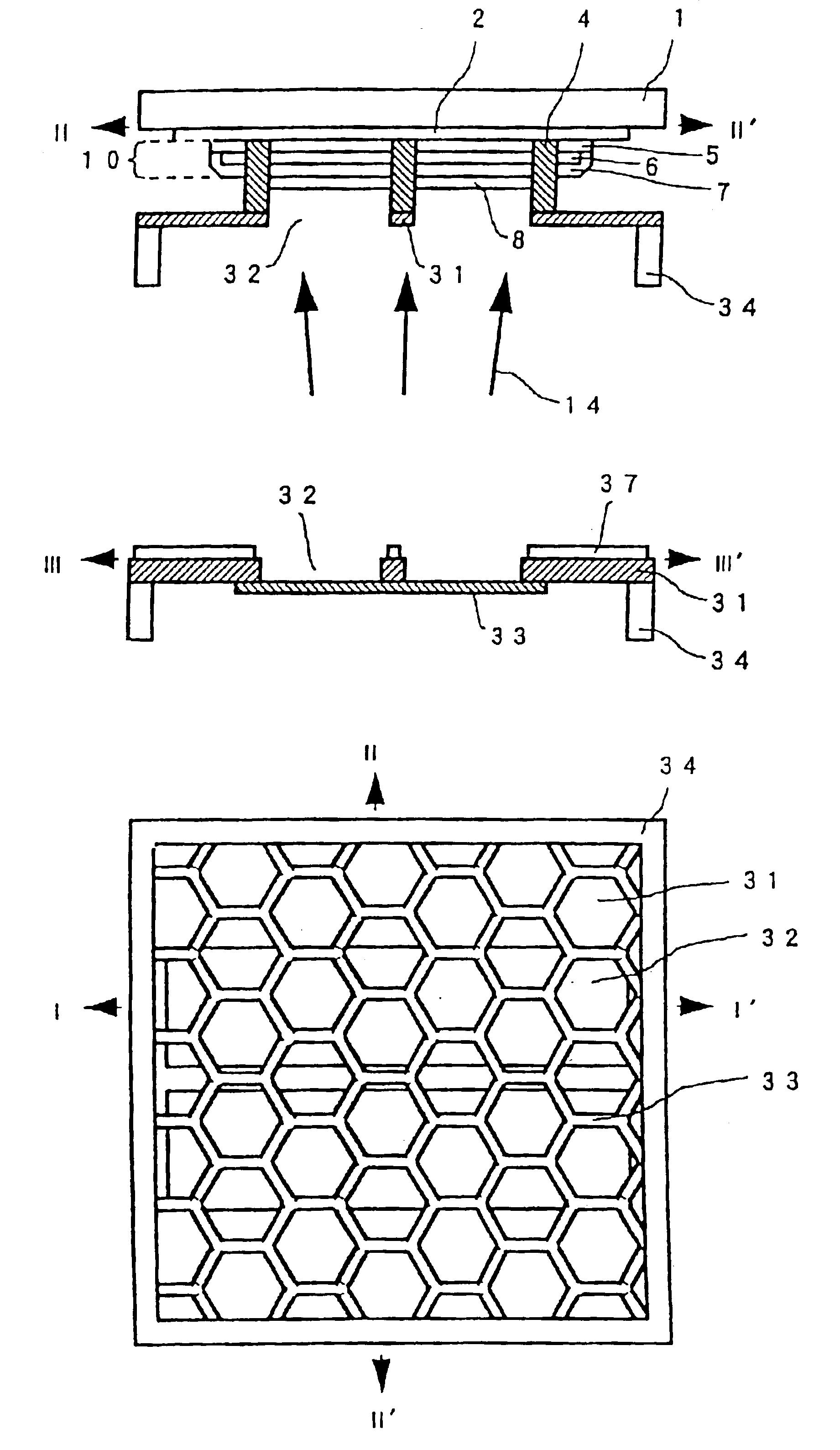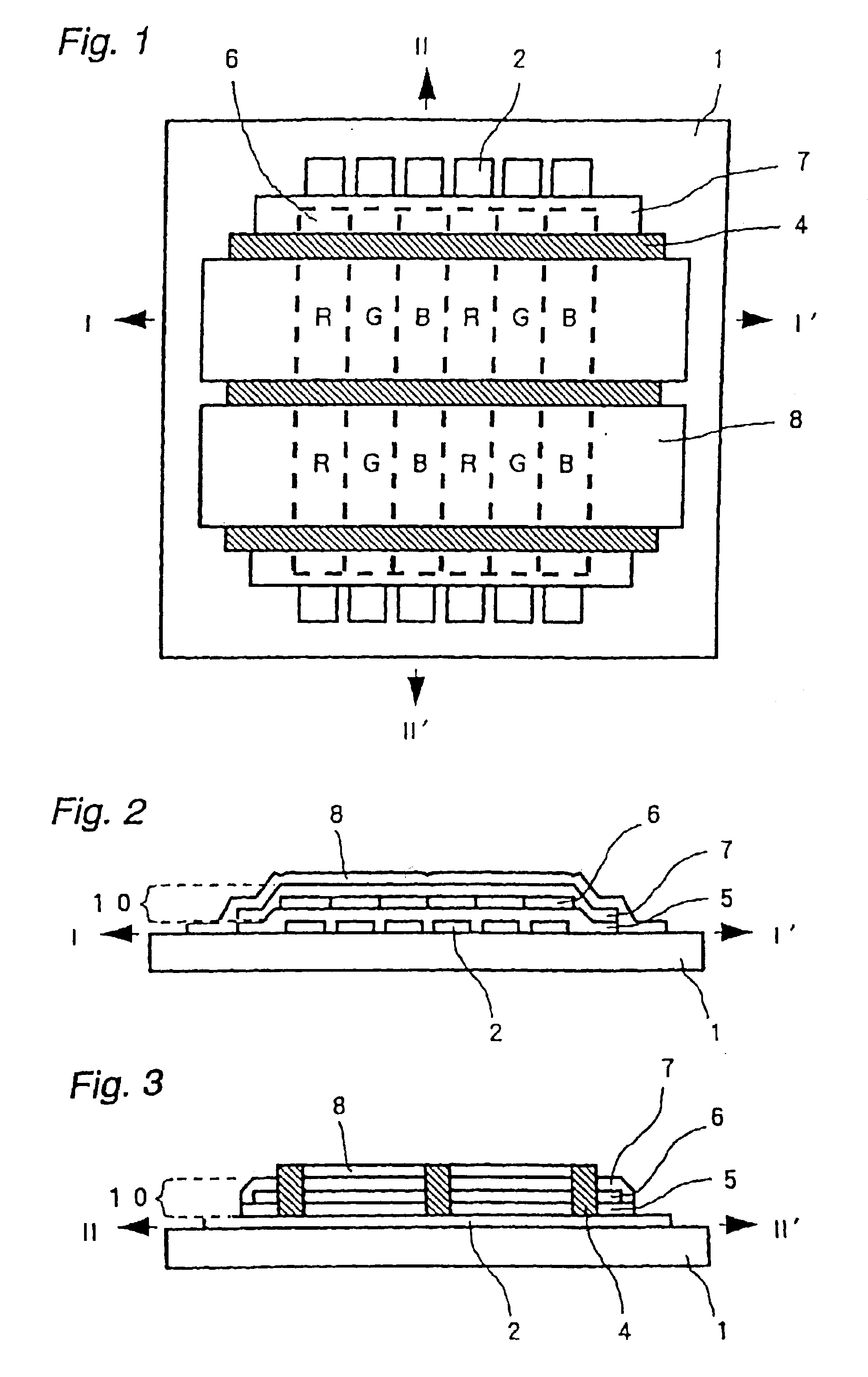Organic electroluminescent device
an electroluminescent device and organic technology, applied in the direction of vacuum evaporation coating, chemical vapor deposition coating, coating, etc., can solve the problems of affecting the performance of the organic electroluminescent element is remarkably degraded, and the materials used are limited, so as to achieve high precision and fine patterning, and simple process without restricting the structure of the electroluminescent devi
- Summary
- Abstract
- Description
- Claims
- Application Information
AI Technical Summary
Benefits of technology
Problems solved by technology
Method used
Image
Examples
example 1
Shadow masks with a structure in which the mask portion and the reinforcing lines were formed on the same plane as shown in FIG. 17 were prepared for patterning the emitting layer. Each of the shadow masks was 120×84 mm in outside form and 25 μm in the thickness of the mask portion 31, and had ninety two 64 mm long 305 μm wide apertures 32 formed in stripes at a pitch of 900 μm in the crosswise direction. At the apertures formed in stripes, 20 μm wide and 25 μm thick reinforcing lines 33 across the apertures were formed at 1.8 mm intervals. Furthermore, the shadow mask was fixed on a 4 mm wide stainless steel frame 34 equal in outside form to the shadow mask.
A shadow mask with a structure in which a clearance 36 was formed between one face 35 of a mask portion 31 and reinforcing lines 33 as shown in FIGS. 30 and 31 was prepared for patterning the second electrodes. The shadow mask was 120×84 mm in outside form and 170 μm in the thickness of the mask portion, and had sixty six 100 mm...
example 2
The process till the formation of the hole transport layer was the same as described for Example 1.
Then, a first shadow mask for the emitting layer was arranged before the substrate, and they were kept in contact with each other. Behind the substrate, a ferrite magnetic shell (YMB-1B produced by Hitachi Metals, Ltd.) was arranged. In this case, as shown in FIGS. 18 and 19, the shadow mask and the substrate were positioned to ensure that the first electrodes 2 formed in stripes were located at the centers of the apertures 32 formed in stripes in the shadow mask, and that the reinforcing lines 33 agreed with the spacers 4 in position and were kept in contact with the spacers. In this state, Alq3 was vapor-deposited by 30 nm, to pattern the G regions of the emitting layer. Then, as described for patterning the G regions of the emitting layer, a second shadow mask for the emitting layer was used to deposit Alq3 with 1 wt % of DCM doped by 40 nm, for patterning the R regions of the emitt...
example 3
As described for Example 1, the ITO was patterned as first electrodes in 90 mm long and 280 μm wide stripes, and the photoresist was removed. As described for Example 1, 272 first electrodes were formed in strips on a glass substrate at a pitch of 300 μm in the crosswise direction.
The spacers were formed as described below. Glycidyl methacrylate was added to a copolymer consisting of 40% of methacrylic acid, 30% of methyl methacrylate and 30% of styrene by 0.4 equivalent for each equivalent of the carboxyl groups of the copolymer for reaction, to obtain an acrylic copolymer with carboxyl groups and ethylene unsaturated groups as side chains. Two hundred parts by weight of cyclohexane were added to 50 parts by weight of the acrylic copolymer, 20 parts of a bifunctional urethane acrylate oligomer (UX-4101 produced by Nippon Kayaku Co., Ltd.) as a photoreactive compound and 20 parts by weight of hydroxypivalate neopentyl glycol diacrylate (HX-220 produced by Nippon Kayaku Co., Ltd.) as...
PUM
| Property | Measurement | Unit |
|---|---|---|
| width | aaaaa | aaaaa |
| width | aaaaa | aaaaa |
| transmittance | aaaaa | aaaaa |
Abstract
Description
Claims
Application Information
 Login to View More
Login to View More - R&D
- Intellectual Property
- Life Sciences
- Materials
- Tech Scout
- Unparalleled Data Quality
- Higher Quality Content
- 60% Fewer Hallucinations
Browse by: Latest US Patents, China's latest patents, Technical Efficacy Thesaurus, Application Domain, Technology Topic, Popular Technical Reports.
© 2025 PatSnap. All rights reserved.Legal|Privacy policy|Modern Slavery Act Transparency Statement|Sitemap|About US| Contact US: help@patsnap.com



